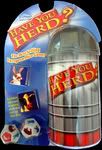
Subject: General
Category:
Ages: 8 and up
# of players: 2-4
Time to play: 30 minutes
Mechanics/Game Type: dice rolling and set collection
Ratings (1 to 5)
Educational Value: 2
Gaming value: 4
Aesthetic value: 5
Price value: 5
Ease of play: 5
Younger adaptability: 4
My comments: Unfortunately, you really have to stretch quite a bit to find the educational value in this game. I say "unfortunately" because other than educational value, Have You Herd is a great game in every other category.
There is a little strategy involved but mostly this game is based on the roll of the dice. The best time to use it is when your children are learning the concept of trading value and even dollar value although there is no money involved. One of the hardest things to get across to young children is that all coins are not created equal nor is all paper money and this game gives them a little practice in trading and learning that they have to trade more items to get a higher valued animal, ie. not everything in life has a one for one value.
Have You Herd is played with a pair of 12-sided dice and 52 animal tiles consisting of rabbits, sheep, pigs, cows, horses and two special animals: the guard dogs and the skunk. Throughout the game you roll to collect more tiles, each one representing a herd. On each turn you have opportunities to trade up for more expensive animals. With 5 rabbits you can trade up for one sheep and for 2 sheep you can trade up for one pig and so on. In the end you want to have one of each herd to win. The strategy comes in when you are trading, for example, it's a good idea to trade for a guard dog early on in the game if you can because he will protect your herds when the fox or the wolf are rolled.
This is an enjoyable game to play, requiring no set up time and is very easy to learn. In fact I'm not sure why the recommended age is 8 and up, I would gauge it at 6 and up without adapting any of the rules. The packaging is compact, everything fits into an adorable 3x6 inch silo. Finally a manufacturer that understands my distaste for wasteful, unnecessary packaging. :)
BoardGameGeek.com link to this game:http://boardgamegeek.com/game/33907













